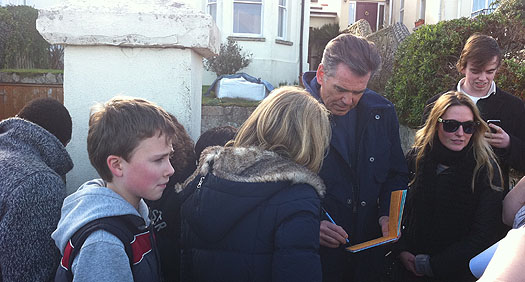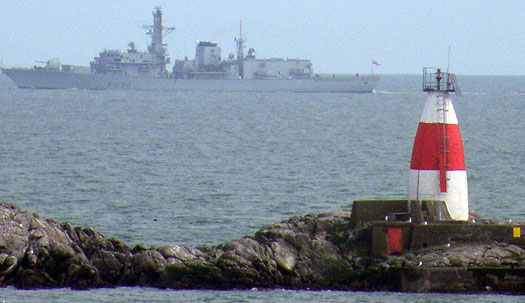Displaying items by tag: news update
Birthday Bash as HMS Belfast Celebrates 75th Anniversary
#HMSBelfast – The Thames floating landmark, HMS Belfast celebrates its 75th anniversary, coinciding with this weekend's St. Patrick festivities held on both sides of the Irish Sea, writes Jehan Ashmore.
The Town-Class cruiser was launched on St. Patrick's Day 1938 from Harland & Wolff, Belfast. She is one of the last surviving WW2 warships remaining in UK waters. She was commissioned into the Royal Navy the following year and placed under the command of Captain G.A. Scott DSO.
During her career, HMS Belfast opened fire in support of Allied troops during the D-Day landing, was on escort duty during Artic convoys of merchant ships in addition to involvement in the Korean War.
To commemorate the historical significance of HMS Belfast, which has been moored on the Thames since 1971 as a major tourist attraction, a series of special events are to be held this weekend.
Her Belfast-based counterpart, the C-Class light cruiser HMS Caroline, which served in World War I having been built in 1914 at Cammell Laird, Birkenhead, lies on the Lagan.
As previously reported, the fate of the former Battle of Jutland survivor was secured following last year's decision to protect the vessel from falling into disrepair with a £1m restoration grant.
On completion of the work on the veteran vessel now in her 99th year, she is to become a major tourist attraction likewise of HMS Belfast.
#Ex007inDalkey- Pierce Brosnan, the Irish born actor and former 007 James Bond, caused quite a stir on the first day of March in Dalkey. The actor was on a location shoot and was understood to be making a TV advert campaign with scenes from the south-side suburb and at Coliemore Harbour, writes Jehan Ashmore.
Dalkey which is well known for its famous string of celebrities, had greeted the Navan born actor's presence with a distinct buzz in the Spring air, as the cameras rolled at the scenic coastal location facing out to Dalkey Island.
For the shoot Brosnan stood at the public viewing area above the harbour, where there is a binocular-scope which is dedicated in the memory of the life and work of the late Dr. John de Courcy Ireland.The former Dalkey resident, was a maritime historian, teacher and linguist and who is widely regarded as the 'father' of Maritime Ireland.
Brosnan played Bond between 1995-2004 during which four films were produced. It was in his second outing as Bond in 'Tomorrow Never Dies' that a Royal Navy frigate, fictitiously named HMS Devonshire made a brief appearance. The frigate was sunk in the South China Sea by a stealth ship, instigated by the evil media mogul magnate Elliot Carver, head of the Carver Media Group Network (CMGN).
By an uncanny coincidence, only a couple of hours before the shoot at Coliemore Harbour took place, HMS Richmond (F239) a sister of the frigate that played the role in the film (in real life HMS Somerset), had sailed past The Muglins lighthouse off Dalkey Island. As previously reported, HMS Richmond, a Duke class frigate was bound for Dublin Port for a courtesy call over the weekend.

007 signs autographs for Dalkey fans. Photo: Gail Bonass

HMS Richmond passes the Muglins on Dublin Bay. Photo: Jehan Ashmore
Brosnan's visit to Dalkey was certainly a surprise for locals and tourists alike and will no doubt assist in boosting visitor numbers. By another coincidence on the same day, the town's Heritage Centre on Castle Street, the main street of the former port town for Dublin during medieval times, reopened after completion of a major upgrade of the visitor centre.
Unlike the former Bond's notable presence, HMS Richmond slipped quietly out of Dublin Bay today. Having said that, could there be a connection!....According to yesterday's Irish Times –The Social Network column, among his next film projects is 'November Man', an espionage movie. He quoted "...the stage is big enough for Daniel and myself".
Growth in Manufacturing Sector Accelerates
#News Update - Ireland's rate of growth in the manufacturing sector accelerated last month as businesses reported signs of strengthening demand.
The latest NCB Manufacturing Purchasing Managers' Index rose to 51.5 in February, up from 50.3 in January. A reading above 50 indicates expansion. Irish manufacturing activity has now expanded for 12 successive months.
A breakdown of the numbers showed new orders returned to growth in February, following a marginal reduction in January. For more on this The Irish Times has a report.
Dalkey Island Oil Licence Surrendered
#DalkeyOilProspect – Providence Resources, who have been planning to explore for oil and gas in Dublin Bay, has surrendered its foreshore licence to the Department of the Environment, reports The Irish Times.
The Dublin based exploration company had planned to drill off the coast of Dalkey, in the Kish Basin.
In a statement this afternoon, the company said it made the decision to surrender the licence when it became clear that elements of an EU directive on environmental impact assessment (EIA) "were not transposed correctly in 1999 by the Irish Government". For more on this story click HERE.
Re-Enactment of Shackleton’s Epic Antarctic Rescue
#EPICVoyage - A crew of five led by British-Australian adventurer, Tim Jarvis, are attempting to become the first to authentically re-enact Sir Ernest Shackleton's Epic 800nm rescue mission across the Southern Ocean from Elephant Island to South Georgia.
The team, are on their 11th day onboard the Alexandra Shackleton which is heading for South Georgia, some 23 nautical miles away. The purpose built 22ft vessel is an exact replica of the lifeboat, James Caird, which made the same journey across the perilous ocean to reach the rugged peaks of the island.
Alexandra Shackleton was named after the Kildare born, polar explorer's only grand-daughter, who as previously reported on Afloat.ie was at the launch of the Shackleton Endurance Exhibition in Dun Laoghaire last September. The exhibition has a wonderful collection of photographs taken by Frank Hurley which relives the abandoning of the exploration ship Endurance, which became crushed in the pack ice, and the subsequent lifeboat rescue mission which can be read HERE in greater detail.
At only 22.5 ft/6.9m, Alexandra Shackleton, is a purpose built exact replica of the lifeboat, James Caird, which made the same journey across the perilous ocean to reach the rugged peaks of South Georgia.
The re-enactment of Shackleton's 'double' journey across sea and land using traditional gear will be according to Jarvis (46), a veteran of multiple polar expeditions, the most challenging expedition of his life.
Shackleton Epic has been in development since 2008, when Shackleton approached Jarvis with the idea of an expedition to honour one of the greatest leadership and survival stories of all time. To keep abreast of news of the re-enactment team, there's a BLOG and to track the vessel's progress, click HERE
French Guiana Well is Dry Says Tullow Oil
#Oil - Tullow Oil's shares dropped more than 6% in London trading early last week with the news that its prospect in the Atlantic off French Guiana is dry, according to The Irish Times.
The Irish-founded oil exploration firm says it encountered a number of oil shows in reservoir quality sands at its Zaedyus-2 well in the waters north of Brazil, but it "did not encounter commercial hydrocarbons".
The result was described as "very disappointing" by Investec Securities analyst Stuart Joyner - though better signs have been seen at the nearby Zaedyus-1 well, drilled by Tullow with partners Royal Dutch Shell and Total at a cost of $250 million.
And as previously reported on Afloat.ie, the UK-based company's prospects off the Ivory Coast and Ghana have proven encouraging for future exploration.
Wreckage Found in Search for Missing Yachtswoman Off Cornwall
#NEWS UPDATE - The Independent reports that the wreckage of a vessel has been found in the search for a missing yachtswoman off the Devon and Cornwall coast.
As previously reported on Afloat.ie, 65-year-old Ona Unwin left Falmouth in Cornwall on Friday in a yacht purchased just the day before.
She was last reported in Mousehole, near Penzance, on Saturday evening after rounding the bottom of the Cornish coast. Relatives raised the alarm on Sunday after she failed to return home to Bideford in Devon.
Devon and Cornwall Police were with members of Unwin's family yesterday afternoon when air and sea search crews discovered the wreckage near Sennan Cove in Cornwall which is believed to be that of her 31-foot Seagair yacht.
No evidence of a body was seen on board the wreck, and a police spokesman said investigations are ongoing.
Meanwhile, it has emerged that Unwin is thought to have dismissed safety warnings about "treacherous" weather in the region over the weekend when she set out.
"I was amazed when I found out that she had set sail," said Jerry Hobkirk, proprietor of Falmouth Yacht Brokers which sold her the yacht last Thursday. "If I had known, we would have stopped her."
Boat Stolen from Dollymount Sea Scouts Recovered by Gardaí
#STOLEN BOAT - Dollymount Sea Scouts have reported the recovery of a boat stolen from their scout den in north Dublin earlier this week.
The BP 18 standard boat was taken from outside the scout den at the Crow's Nest in Dollymount at some time between the hours of 5pm on Sunday 16 and 5pm on Monday 17 September.
But eagle-eyed gardaí in a patrol car from Santry spotted the boat in the driveway of a derelict house in a north Dublin housing estate.
The boat, Orion 2, was towed back to Santry Garda Station from where it was picked up by the sea scouts and brought home to Dollymount on Tuesday evening.
The brand new boat has a red fibreglass hull with brown varnished timber thwarts and gunwales, and is painted light grey inside. The boat is 18ft long and was last seen on its four-wheel trailer.
This type of boat is only used by Sea Scouts in Ireland and An Slua Muiri (Irish Navel Reserves). It has only been used a handful of times since its launch in May this year, and only one of this particular kind has been manufactured recently.
Double Tragedy for Beara Peninsula as Retired Teacher Drowns
#NEWS UPDATE - The Irish Times reports that the body of a retired schoolteacher was recovered from the sea off Castletownbere in West Cork on Friday in the second tragedy the area has seen this week.
Sixty-six-year-old Pearse Lyne drowned after his fishing boat capsized in poor weather off the Beara Peninsula.
A search operation was launched around 1.30pm after a cliffwalker spotted the upturned vessel near the Dzogchen Buddhist retreat, and the body of the father of four and former national school principal was discovered some 90 minutes later in the water near Pulleen harbour.
The sad incident occurred just says after farmer and poet John O'Leary drowned off Cod's Head when the Enterprise sailing dinghy he was sailing with his teenage son Christopher capsized.
As previously reported on Afloat.ie, Minister for the Marine Simon Coveney paid tribute to O'Leary as well as Quilty fishermen Michael Galvin and Noel Dickinson, who drowned earlier this week off the Clare coast.
Meanwhile, in Dongeal a diver was rescued after getting into difficulty in Lough Salt on Thursday evening, according to the Donegal Democrat.
The Donegal native was one of two divers in the lough at the time, and is believed to have experienced buoyancy issues while some 50m below the surface.
He was taken to Letterkenny General Hospital and later transferred to Craigavon for treatment for decompression sickness. The man is now recovering.
His diving partner, an Italian national living in Ireland, made it to shore unharmed.
Huge Haul of Silver Salvaged from WW2 Wreck off Galway
#SHIP'S SILVER SALVAGE – A record breaking 48 tonnes of silver bullion has been recovered from S.S. Gairsoppa, a 412-ft British cargoship that was torpedoed by U-Boat in WWII and sank some 300 miles south-west of the Galway coast in 1941.
The salvage operation was carried out by Odyssey Marine Exploration, in depths of three-miles, where the hoard of 1,203 bars or approximately 1.4 million troy ounces of silver was retrieved.
According to the US based company it is the heaviest and deepest recovery of precious metals salvaged from a shipwreck, which was undertaken by chartering the Seabed Worker.
The wreck of S.S. Gairsoppa lies in international waters at 4,700m and was firstly discovered using sonar by the chartered Russian research vessel RV Yuzhmorgeologiya and followed by visual inspection by a remotely operated vehicle (ROV) from the Odyssey Explorer.
During the War, the UK Government insured privately owned cargo under their War Risk Insurance program. After making an insurance payment of approximately £325,000 (1941 value) to the owners of the silver cargo lost aboard the Gairsoppa, the UK Government became the owners of the insured cargo.
As some sources, including "Lloyd's War Losses" indicate a total silver cargo worth £600,000 (1941 value) lost aboard the Gairsoppa, there may have been additional government-owned silver cargo aboard that would have been self-insured.
After unloading the precious cargo from the salvage-ship, the cargo was located in a secure facility in the UK. Odyssey claim that the amount of silver bars recovered so far represents approximately 43% of the insured silver bars, or approximately 20% of the total silver cargo which research has indicated may be on board.
The salvage-ship was to take on fuel and change of personnel, where recovery operations will continue back at the wreck of S.S. Gairsoppa and are expected to be completed in the third quarter of 2012.
In addition, an estimated 600,000 oz. of insured silver is expected to be found on S.S. Mantola, another shipwreck recovery project being conducted in conjunction with the Gairsoppa project.
Odyssey is conducting the Gairsoppa project under contract with the UK Department for Transport. Under the terms of the agreement, which follows standard commercial practices, Odyssey bears the risk of search and recovery and retains 80% of the net salved value of the ship's silver cargo after recovering its expenses.






































































